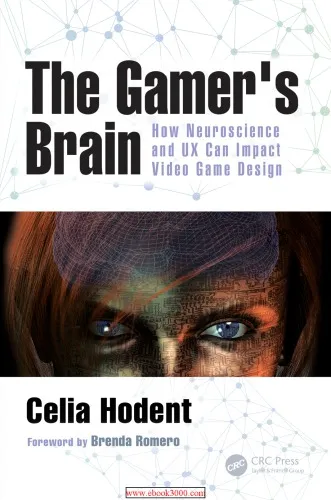The gamer's brain: how neuroscience and UX can impact video game design
4.3
بر اساس نظر کاربران

شما میتونید سوالاتتون در باره کتاب رو از هوش مصنوعیش بعد از ورود بپرسید
هر دانلود یا پرسش از هوش مصنوعی 2 امتیاز لازم دارد، برای بدست آوردن امتیاز رایگان، به صفحه ی راهنمای امتیازات سر بزنید و یک سری کار ارزشمند انجام بدینمعرفی کتاب The Gamer's Brain
کتاب The Gamer's Brain: How Neuroscience and UX Can Impact Video Game Design اثر سیلیا هودنت (Celia Hodent)، یک منبع بینظیر برای درک عمیقتر آثار شناختی (cognitive science) و تجربه کاربری (UX) بر طراحی بازیهای ویدئویی است. این کتاب به طور خاص بر ترکیب اصول علوم شناختی با طراحی تجربه عالی برای بازیکنان بازیهای ویدئویی تمرکز دارد. مخاطبان اصلی این اثر طراحان بازی (game designers)، روانشناسان، متخصصان UX، و هرکسی است که علاقهمند به شناخت بیشتر ارتباط مغز انسان با فرایند طراحی بازی است.
خلاصهای جامع از کتاب
کتاب «مغز بازیکن» در سه بخش اصلی ارائه شده است. بخش اول، اصول اولیه علوم شناختی را بررسی میکند: چگونه مغز انسان اطلاعات را دریافت، تجزیه و تحلیل، و ذخیره میکند. مفاهیم کلیدی مانند توجه (attention)، حافظه (memory)، و بار شناختی (cognitive load) آنالیز میشوند. نویسنده این دانش تئوریک را به نیازهای طراحی بازی تبدیل میکند و توضیح میدهد چگونه میتوان ذهن بازیکن را با دقت مدیریت کرد تا بازیها جذابتر شوند.
در بخش دوم، تمرکز به UX (تجربه کاربری) منتقل میشود. سیلیا هودنت توضیح میدهد که به کمک اصول UX میتوان دنیای بازی را برای بازیکن شفافتر و رضایتبخشتر کرد. او درباره اهمیت جریان (flow) و نحوه هدایت بازیکنان از طریق یک تجربه بازی معنادار با ترکیب هنر، طراحی و فناوری صحبت میکند.
بخش سوم بیشتر به مطالعات موردی و پیادهسازی عملی اختصاص دارد. این بخش راهنماییهایی برای تیمهای طراحی بازی ارائه میدهد تا مهارتهای UX خود را بهبود بخشند و رویکردهای کارآمدتری برای رفع مشکلات رایج در صنایع بازی اتخاذ کنند.
نکات کلیدی کتاب
- درک عناصر شناختی مانند توجه و حافظه برای جذب مخاطب بسیار حیاتی است.
- بار شناختی باید در طراحی بازی به حداقل برسد تا بازیکن به راحتی با گیمپلی هماهنگ شود.
- ایجاد جریان (flow) میتواند تجربهای بینهایت لذتبخش و فراموشنشدنی ایجاد کند.
- UX Design تنها به زیبایی محیط کاربری محدود نیست و مستقیماً بر جذابیت و موفقیت بازی تأثیر میگذارد.
- نمونهبرداری و ارزیابی مکرر بازی بخشی اساسی از روند طراحی است.
نقلقولهای معروف کتاب
"The best video games combine science, art, and technology to create engaging experiences while mitigating frustration."
"Neuroscience teaches us how players perceive their environment, and UX principles help us make their journey meaningful."
"Attention is a limited resource. A good game design respects this limitation and knows how to guide the player's focus."
چرا این کتاب مهم است؟
کتاب «The Gamer's Brain» نه تنها یک منبع علمی معتبر، بلکه راهنمای عملی مفید برای بهبود طراحی بازی است. تخصص نویسنده در روانشناسی و تجربه عملی او در توسعه بازی، باعث شده است که این اثر بینشهای بینظیری برای طراحان بازیهایی ارائه دهد که به دنبال ایجاد تجربههای بینقص و جذاب هستند. این کتاب همچنین به کسانی که به روانشناسی شناختی و کاربرد آن در دنیای دیجیتال علاقهمندند، دیدگاهی روشن و کاربردی میدهد.
اگر به دنبال راهی برای ایجاد بازیهایی هستید که بازیکنان را تحت تأثیر قرار دهند و تجربهای منحصر به فرد به آنان ارائه کنند، این کتاب ضروری است. حضور پررنگ علوم شناختی و UX در طراحی بازیها، نشاندهنده تأثیر عمیق علمی در این هنر مدرن است.
Introduction to "The Gamer's Brain: How Neuroscience and UX Can Impact Video Game Design"
Welcome to a comprehensive exploration of the intricate relationship between neuroscience, user experience (UX), and video game design. Written by Celia Hodent, an expert in cognitive science and UX, "The Gamer's Brain" bridges the gap between the science behind how people think and feel, and the art of creating engaging, enjoyable video games. This book provides practical insights and science-backed guidance for game developers, designers, and anyone curious about how human psychology influences the gaming experience.
In the world of video game design, understanding how the brain functions and processes information is critical to creating immersive and accessible experiences. "The Gamer’s Brain" explains how cognitive science principles, when applied thoughtfully, can enhance video game design to not only capture attention but keep players engaged on a deeper level. Design challenges such as user onboarding, maintaining flow, combating frustration, and encouraging engagement are tackled through a holistic neuroscience and UX lens.
Whether you're a seasoned game developer, a UX professional, or a neuroscience enthusiast intrigued by the gaming industry, this book delivers actionable frameworks, relatable examples, and thought-provoking concepts to redefine your perspective on what makes a game truly succeed. Let’s dive into the main themes and ideas that make "The Gamer's Brain" an essential read.
Detailed Summary of the Book
At its core, "The Gamer’s Brain" is structured around the universal principles of cognitive science and UX design, applied to video games.
The book begins by introducing the basics of cognitive psychology, such as perception, memory, attention, motivation, and learning. It explains how these cognitive systems impact the way players interact with games and make key decisions. With everyday examples and game-specific scenarios, readers gain a foundational understanding of how cognitive limitations, such as the constraints of working memory, shape the player experience.
As the book progresses, Hodent delves deeper into how UX design principles can solve common issues in game development. Topics include maintaining the "flow" state in gameplay, creating intuitive controls, designing informative tutorials, handling cognitive load, and mitigating frustration points. Throughout, Hodent emphasizes the iterative process of design: learning through feedback, testing prototypes, and refining ideas collaboratively to meet players’ needs.
One of the standout aspects of the book is its attention to accessibility and inclusivity. Cognitive science tools are presented as a way to design games for a wider audience, including players with different levels of experience, abilities, or even disabilities. The scientific insights offered here empower developers to deliver meaningful & fun gaming experiences for everyone.
Key Takeaways
- The brain processes information in limited ways; designing inclusive and accessible games requires developers to account for these constraints.
- Effective onboarding and tutorials help players understand games without overwhelming them early on.
- "Flow" is essential for immersive gaming experiences; finding the balance between challenge and skill level is crucial.
- Playtesting and user feedback are indispensable for refining game design and solving potential UX issues.
- Inclusivity doesn’t just mean accommodating disabilities—it also means considering diverse audiences and their perspectives.
Famous Quotes from the Book
"Games are systems designed to engage players, and understanding the human brain is the key to creating systems that resonate."
"Without considering cognitive load, even the most visually stunning and well-animated games will fail to capture their audience."
"UX is not about making a product look good—it’s about making a product feel good to use."
Why This Book Matters
The relevance of "The Gamer's Brain" lies in its ability to blend neuroscience with actionable design strategies to transform how games are developed and experienced.
In an industry driven by innovation, developers face constant pressure to create games that not only entertain but also provide memorable experiences. This book offers a scientific methodology for addressing questions like: How can we make games too "sticky" to quit? How can onboarding feel seamless, not frustrating? And how do we foster deep emotional or cognitive connections between players and the games they play?
Celia Hodent’s approach equips creators with tools to tackle these challenges, not just from an artistic viewpoint, but from a user-centered perspective. It’s insightful for UX professionals and game developers hoping to deliver experiences that truly cater to their player base. Moreover, cognitive science and UX insights have value beyond gaming, applying equally in fields like education, management, and interactive design.
Ultimately, "The Gamer's Brain" is a call to action for creators to embrace empathy, experimentation, and evidence-based design, ensuring that gaming remains one of the most dynamic and enriching forms of entertainment in the modern era.
دانلود رایگان مستقیم
برای دانلود رایگان این کتاب و هزاران کتاب دیگه همین حالا عضو بشین
برای خواندن این کتاب باید نرم افزار PDF Reader را دانلود کنید Foxit Reader
دسترسی به کتابها از طریق پلتفرمهای قانونی و کتابخانههای عمومی نه تنها از حقوق نویسندگان و ناشران حمایت میکند، بلکه به پایداری فرهنگ کتابخوانی نیز کمک میرساند. پیش از دانلود، لحظهای به بررسی این گزینهها فکر کنید.
این کتاب رو در پلتفرم های دیگه ببینید
WorldCat به شما کمک میکنه تا کتاب ها رو در کتابخانه های سراسر دنیا پیدا کنید
امتیازها، نظرات تخصصی و صحبت ها درباره کتاب را در Goodreads ببینید
کتابهای کمیاب یا دست دوم را در AbeBooks پیدا کنید و بخرید


